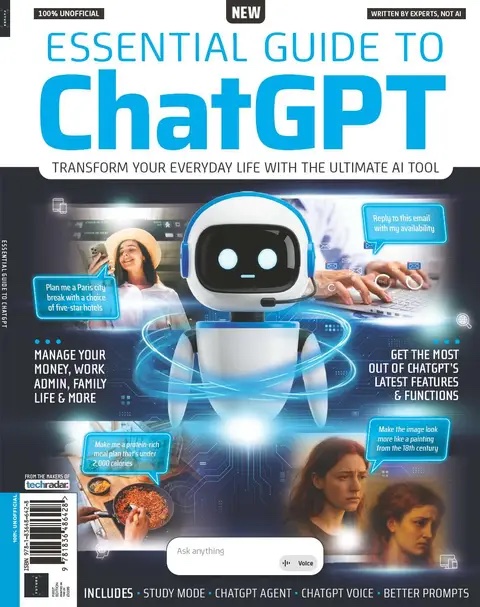7 ways ChatGPT can help you plan the perfect vacation


This article is part of TechRadar's AI Week 2025. Covering the basics of artificial intelligence, we'll show you how to get the most from the likes of ChatGPT, Gemini, or Claude, alongside in-depth features, news, and the main talking points in the world of AI.
I’ll admit it: planning a holiday can be more stressful than the job you’re supposed to be taking a break from. Flights, hotels, itineraries, translations. It’s a mess of tabs, apps, and endless “best places to stay” articles that all seem suspiciously similar.
So, I did what I always do these days when life admin threatens to derail me: I turned to AI. And honestly? It’s like having the world’s most patient travel agent in your pocket.
1. Pick the right destination

The first challenge when going on holiday is always deciding where to go. You might know you want sunshine or a city break, but the world is a big place. AI can cut through the indecision by helping you narrow things down. Ask it to suggest destinations based on your budget, time of year, and interests, and it will quickly compile a list that makes sense.
In my example, ChatGPT offered a mix of classic European getaways and a few more adventurous picks. Denmark and Sweden were obvious, but it also suggested Bulgaria, which I hadn’t even considered. It didn’t just list cities either. It explained why Sofia could be a good choice in November, complete with average temperatures and the bonus of fewer tourists.
Instead of trawling through generic “top ten destinations” articles, you get suggestions tailored to you. It feels like brainstorming with a travel-savvy friend rather than battling Google search results
2. Find flights without losing your sanity
Start with the worst part: flights. Normally, I’d spend hours comparing Skyscanner, Google Flights, and random airline sites, trying to decide whether saving £30 is worth leaving at 6 a.m. with a four-hour layover in Frankfurt. With ChatGPT or Gemini, though, you can set the rules up front. Within seconds, you get a neat shortlist that respects your time as much as your wallet.
It’s not magic. It’s still pulling from flight data you could find yourself, but the difference is the filter. Instead of manually checking every option, the AI does the tedious comparisons and hands you the good stuff.
Sign up for breaking news, reviews, opinion, top tech deals, and more.
You can even push it further by asking for recommendations on which days to travel. AI will factor in price fluctuations and highlight when you’re better off leaving on a Tuesday instead of a Saturday. This kind of advice used to be buried in forums and travel blogs. Now it’s instant.
3. Hotels without the booking regret
Picking where to sleep is another stress trigger. I’ve lost count of the times I’ve booked a “charming boutique hotel” only to find out “charming” actually means “next to a motorway.” This is where AI shines again. You can ask ChatGPT for a mix of budget, style, and location, and the AI will deliver options you can trust without the usual doomscroll through hundreds of TripAdvisor horror stories.
It’s not replacing the big booking platforms, but it makes them usable. Instead of endless filters and pop-ups trying to upsell breakfast I don’t want, I get exactly what I asked for.
Another underrated trick is asking AI to compare hotels across different booking sites. It can flag if Booking.com has a better cancellation policy than Expedia or if the official hotel website is running a discount you might miss. This saves money and avoids the sinking feeling when you realize you could have booked the same room cheaper.
4. City guides that don’t feel generic

Here’s where it gets really cool. AI city guides are way better than the “Top 10 Things to Do in…” lists that clog up Google. If you’re heading to Rome, sure, you’ll see the Colosseum. But what about that family-run trattoria where the menu hasn’t changed since the ’70s? AI can personalise your itinerary based on you.
When I asked for a two-day Kyoto food crawl, I got a plan that jumped between ramen shops, markets, and a whisky bar I’d never have found otherwise. The itinerary included timings, walking directions, and even estimated costs for each stop. It felt like a friend had scribbled a plan for me, not like I’d been handed a tourist brochure.
Even better, you can mix AI’s recommendations with your own priorities. Want a balance of sightseeing, food, and downtime? Ask for it. Fancy a pub crawl that mixes craft beer with live music? No problem. The itineraries are flexible and easy to tweak, which makes them a nice alternative to static guidebooks.
5. Translation made simple

This article originally appeared as part of Essential Guide to ChatGPT, available now at MyFavoriteMagazines. Essential Guide to ChatGPT is full of top tips and expert advice, covering everything you need to know about the world’s most popular AI – from the basics to some of its latest features and functions.
Nothing kills holiday confidence faster than standing in a restaurant abroad, staring at a menu you don’t understand. Traditional translation apps help, but AI has taken things up a notch.
Apple’s new translation features in iOS, powered by Apple Intelligence, make it possible to have fluid conversations with someone who doesn’t speak your language. I tested it by pretending to chat with my Italian in-laws, and it was surprisingly smooth. Instead of clunky word-by-word translations, it felt like a real conversation.
I’m a big fan of Apple’s offering, but it doesn’t come close to the prowess of ChatGPT when it comes to translation. ChatGPT allows you to upload images of text in foreign languages and ask for a translation. While booking my holiday to Japan, I’ve accessed lots of Japanese sites with no English translation. Luckily, ChatGPT makes understanding and reading another language incredibly easy.
6. Travel admin you actually finish

Planning isn’t just about picking fun things to do. There’s the admin side too: visas, insurance, packing lists. These are boring but essential. AI is surprisingly helpful here as well.
Ask for a packing list for “a week in Barcelona in June, staying in a mid-range hotel, with a focus on food and sightseeing,” and you’ll get a detailed checklist that covers everything from clothes to plug adapters. No more panicked runs to the airport shop because you forgot a charger.
Visa and entry requirements are another headache. AI can’t replace official government websites, but it can point you in the right direction. If you ask about entry rules for Japan, it will summarise what you need and direct you to the correct official page to double-check. That saves time and avoids falling down a rabbit hole of outdated travel forums.
7. The fun extras

Once the essentials are sorted, you can start using AI for the fun stuff. Want personalised restaurant recommendations that avoid tourist traps? Ask for “hidden gems in Kyoto that locals love” and you’ll get a list of places that rarely show up in mainstream guides.
Looking for activities for kids? AI will generate itineraries that balance museums, parks, and fun stops without overloading the day. Even better, you can ask it to adjust for the weather. If it rains, your sunny beach day can turn into an indoor adventure plan in minutes.
For sports fans, AI can even scan local fixtures. Heading to New York? It will tell you if the New York Knicks are playing at Madison Square Garden while you’re in town. That’s the sort of detail that can transform a trip from good to unforgettable.
Why AI doesn’t replace experience
All of this might sound like AI makes travel planning effortless. It certainly removes a lot of friction, but it’s not perfect. Sometimes the recommendations can be a little too polished or lean heavily on popular spots. That’s why the best approach is to use AI as a starting point, then layer in your own research and instincts.
AI gives you the scaffolding. You add the colour. That combination is what turns a decent trip into a great one.
Holidays are meant to be a break, not another spreadsheet of decisions to make. AI helps strip out the boring parts of planning and replaces them with quick, clear answers. You still get to make the choices, but without the noise.
Whether it’s finding flights that don’t leave at ridiculous times, avoiding hotels that look better in photos than reality, or finally cracking a menu in a language you don’t speak, AI makes the whole process easier. And if you can spend less time planning and more time looking forward to the trip, that feels like the real holiday win.
Follow TechRadar on Google News and add us as a preferred source to get our expert news, reviews, and opinion in your feeds. Make sure to click the Follow button!
And of course you can also follow TechRadar on TikTok for news, reviews, unboxings in video form, and get regular updates from us on WhatsApp too.

➡️ Read our full guide to the best business laptops
1. Best overall:
Dell Precision 5690
2. Best on a budget:
Acer Aspire 5
3. Best MacBook:
Apple MacBook Pro 14-inch (M4)

John-Anthony Disotto is TechRadar's Senior Writer, AI, bringing you the latest news on, and comprehensive coverage of, tech's biggest buzzword. An expert on all things Apple, he was previously iMore's How To Editor, and has a monthly column in MacFormat. John-Anthony has used the Apple ecosystem for over a decade, and is an award-winning journalist with years of experience in editorial.
You must confirm your public display name before commenting
Please logout and then login again, you will then be prompted to enter your display name.